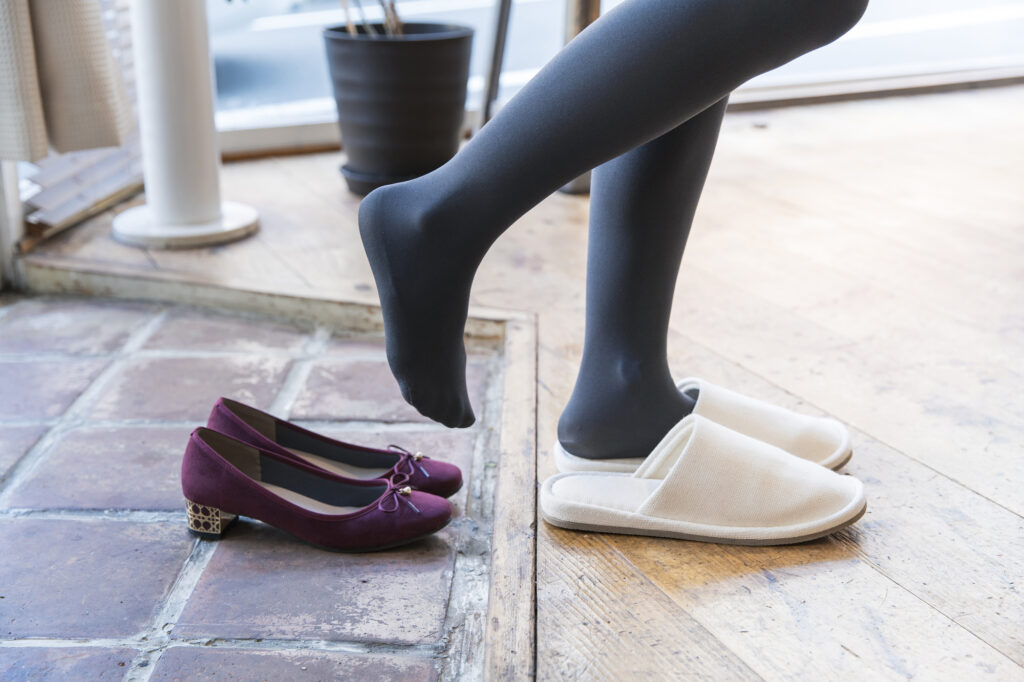There are many cultural traditions and societal norms associated with the Japanese people. From bowing to show respect, to making slurping noises when eating noodles, there are plenty of customs every visitor should know before traveling to the country. One of the most commonly cited, yet misunderstood, is the custom of taking off shoes before entering a building.
The Japanese take their etiquette seriously, and as a respectful visitor, you should too. Removing your shoes before entering certain indoor spaces is just one of the rules of etiquette that you’ll need to follow during your trip to Japan. It starts by understanding when and why to remove your shoes.
Here’s everything you need to know about taking off your shoes in Japan, and what it means to properly observe this important custom.

Why do you take your shoes off in Japan?
Put simply, Japanese people take off their shoes for cleanliness. Centuries ago—and still today—Japanese traditionally ate meals while sitting on tatami mats rather than in chairs. They also made their beds on tatami mats, sleeping on futons very close to the floor. To keep the tatami surface clean, Japanese people removed their shoes before entering their homes to prevent a dirty floor.
Today, the roots of this tradition are still true to cleanliness; however, it’s also a sign of respect. When you step into someone’s home or into their place of business, taking off your shoes is a sign of respect. Removing your shoes ensures that you won’t track in dirt and debris, and that you respect the host enough to be mindful of your presence in their facilities.
Taking off your shoes before entering someone’s home or stepping foot onto traditional tatami flooring sets a respectful tone right from the start. This is why it’s such an engrained part of Japanese culture and everyday life.
When to take your shoes off
The Japanese people—and visitors to the country—still remove their shoes today, not just out of tradition, but to preserve cleanliness in the home and other indoor spaces. Generally, anywhere a tatami mat is present, it should be a signal for you to remove your shoes before stepping on the surface. Likewise, as we’ll discuss below, anytime you see a threshold with a step, it’s an opportunity to slip off your shoes.
When you enter a traditional Japanese house, you’ll need to remove your shoes and put on a pair of slippers, when provided. There are also several other situations and spaces where you’ll be asked to remove your shoes, each requiring certain forms of etiquette. As a respectful visitor in Japan, you’ll need to take of your shoes in the following situations:
In someone’s home
You should always take your shoes off before entering a residence in Japan. In most Japanese homes, there’s often a difference in levels at the entrance, called a genkan. This is the spot where you remove and set your shoes while you’re spending time inside the home. The genkan is a small area right after the front door but separate from the rest of the house. It’s still considered the “outside” of the home, and there’s a 3-centimeter step up where the “inside” begins.
In some restaurants
Some restaurants—usually traditional restaurants with low tables—require diners to take off their shoes before entering the premises. Often, there’s a level difference, or genkan, at the entrance like you see in many Japanese homes. Keep in mind, if you see a tatami mat in the space, remove your shoes before walking on it.
In some stores
Some traditional stores, like kimono shops that often have tatami mats, require patrons to remove their shoes while shopping. If you see lots of shelves or lockers near the entrance, especially ones filled with shoes, it’s a good sign you should take off your shoes before entering that shop. Many shops in tourist areas also have signs to indicate shoe removal beyond a certain point.
In shrines and temples
Shrines and temples are sacred and as such, it’s customary to treat them with the utmost respect. This means removing your shoes before you choose to enter one. Look for signage outside the temple that tells you when to remove your footwear and where to store it while you’re paying your respects.
At tea ceremonies
Since tea ceremonies are held in tatami rooms, you need to take off your shoes before entering. Remember, tatami mats and flooring are a universal sign in Japan that you need to remove your shoes, so whenever you spot these traditional, finely woven rush and cloth mats, make sure your shoes are off.
These aren’t the only places where you might be asked to proceed without footwear; however, they’re the most common situations tourists are likely to find themselves in. Keep your eye out for genkan when entering buildings, as well as lockers and shelves for shoe storage. Pay attention to signage and, when in doubt, ask if shoes are okay or where you should store them.
Where to put your shoes after taking them off
What do you do after you remove your shoes at a Japanese home, business, shop, shrine or anywhere else? In commercial spaces, you may see shelves or lockers for storing your shoes. If you’re at a location that has a genkan, you can leave the shoes at the entrance before stepping in, unless there’s a shoebox provided.
There’s even a correct way to place your shoes at the entrance! Make sure the toes are pointing toward the outside, so you can put your shoes on and start walking immediately as you leave the building.
Do not toss them in a corner or leave them in a jumble wherever you take them off! Japanese culture is all about order and organization, and it’s considered rude to simply leave your shoes laying around.
Tips for taking off your shoes in Japan
Something as simple as removing your shoes can be a daunting task when visiting Japan, since there are specific rules of etiquette to follow. What if you’re not wearing socks? Should you bring your own slippers everywhere? Are there any rules about wet shoes?
First-time visitors to Japan tend to have a lot of questions about shoe etiquette. Thankfully, it’s easier to follow protocol than you might think. Make it easy on yourself during your travels by adhering to these simple tips:
- When taking off your shoes in a genkan, make sure your feet or socks never touch the genkan floor. Instead, step right up into the building after removing your shoes and put slippers on (if available).
- Speaking of slippers, it’s considered respectful to accept them if offered. Slippers aren’t common in commercial settings. Instead, you might find yourself presented with some when visiting someone’s house.
- If you’re using slippers, make sure to put them back where you got them. If they were on the floor, twist them in the right direction—with toes facing the inside—for the next guest. Don’t let slippers touch the entryway flooring after a genkan.
- Whenever you spot a tatami mat, see it as a sign to remove your shoes. You should also take off your slippers, too. Traditionally, socks are the only footwear permitted on tatami flooring.
- Always travel with clean socks in Japan. You’ll be taking off your shoes a lot during your travels and it’s best to stay prepared with a fresh pair of socks. While there’s no stipulation for what kind of socks you might bring, it’s best to stick with a simple pair of white socks, which are often seen to reflect the cleanliness aspect of this tradition.
- Make sure your socks don’t have holes in them. While it isn’t a cultural faux pas, arriving to a restaurant or someone’s house with holes in your socks is an embarrassing moment you can avoid.
if you’re visiting somewhere for the first time, it’s often best to follow the leader. Let someone else go ahead of you to lead the way, and observe their shoe etiquette.
Prepare to leave your shoes at the door
Part of the joy of visiting a new country is experiencing as many of the unique cultural traditions as possible. As you plan your trip to Japan, keep shoe etiquette in mind. Taking the time to understand this cultural formality and the history behind it is a great way to show yourself as a respectful visitor during your time in the country.
If you’re still worried about when and how to take your shoes off, it’s recommended to keep things simple. Pack a pair of shoes or two that are easy to take off—and make sure to bring clean socks—to prepare for these situations and to maintain proper etiquette during your travels. Pay attention to your surrounding as you enter a building and look to see how others observe the practice.
Like all new cultural practices, you’ll quickly become adept to removing your shoes in Japan. By the end of your trip, you’ll start to automatically recognize situations where you need to take off your shoes, as well as when to keep them on.
- How Much Money Can You Make Teaching English in Japan? - December 12, 2022
- The Best Places to Teach English in Japan - December 9, 2022
- The Best Credentials for Teaching English in Japan - December 8, 2022








